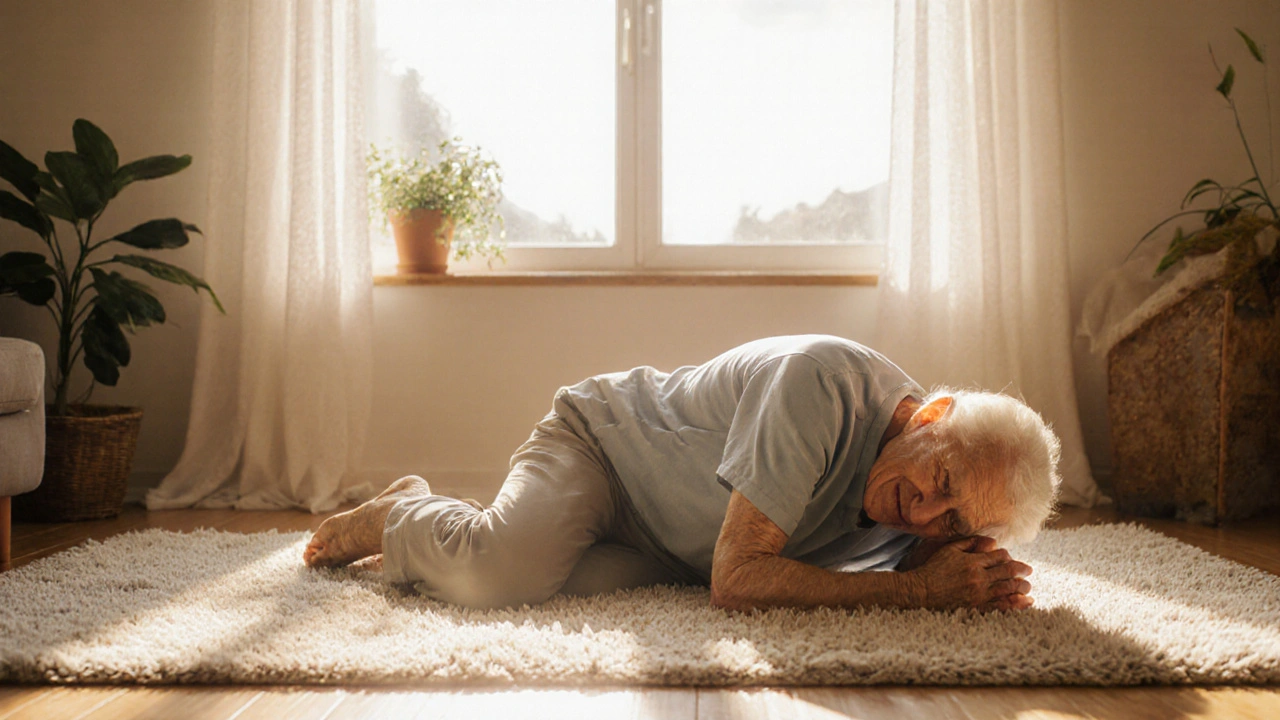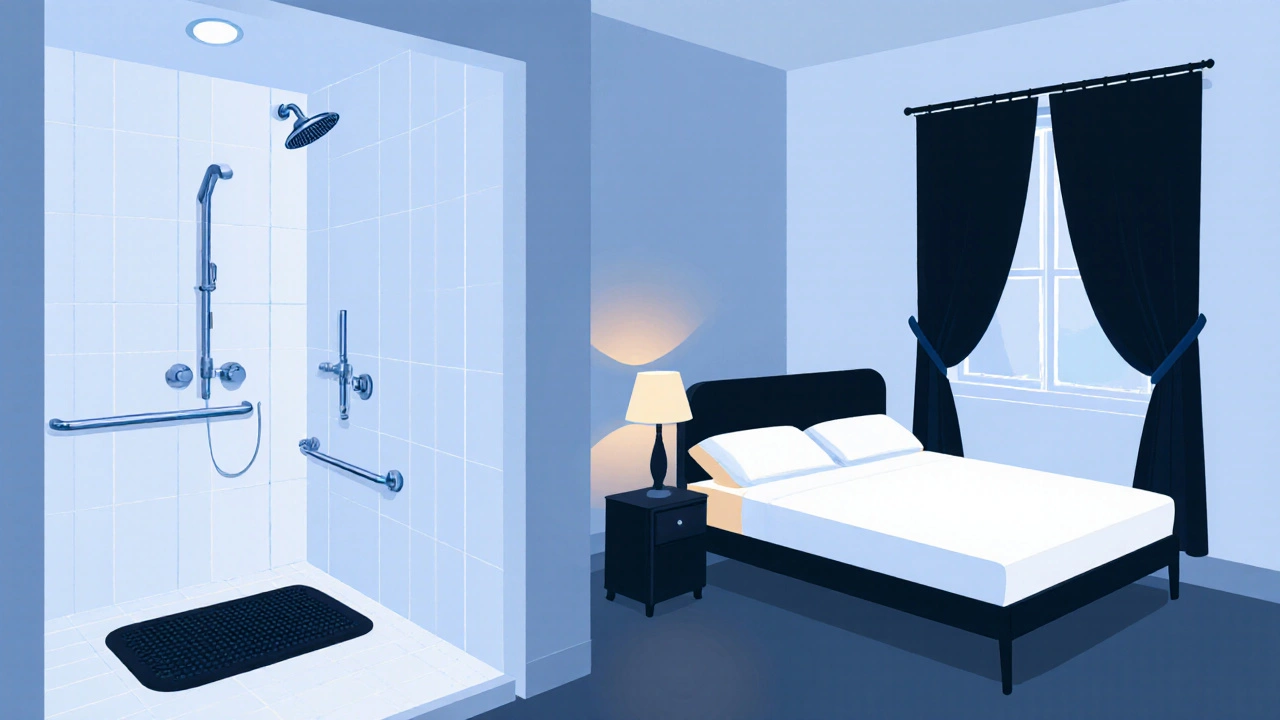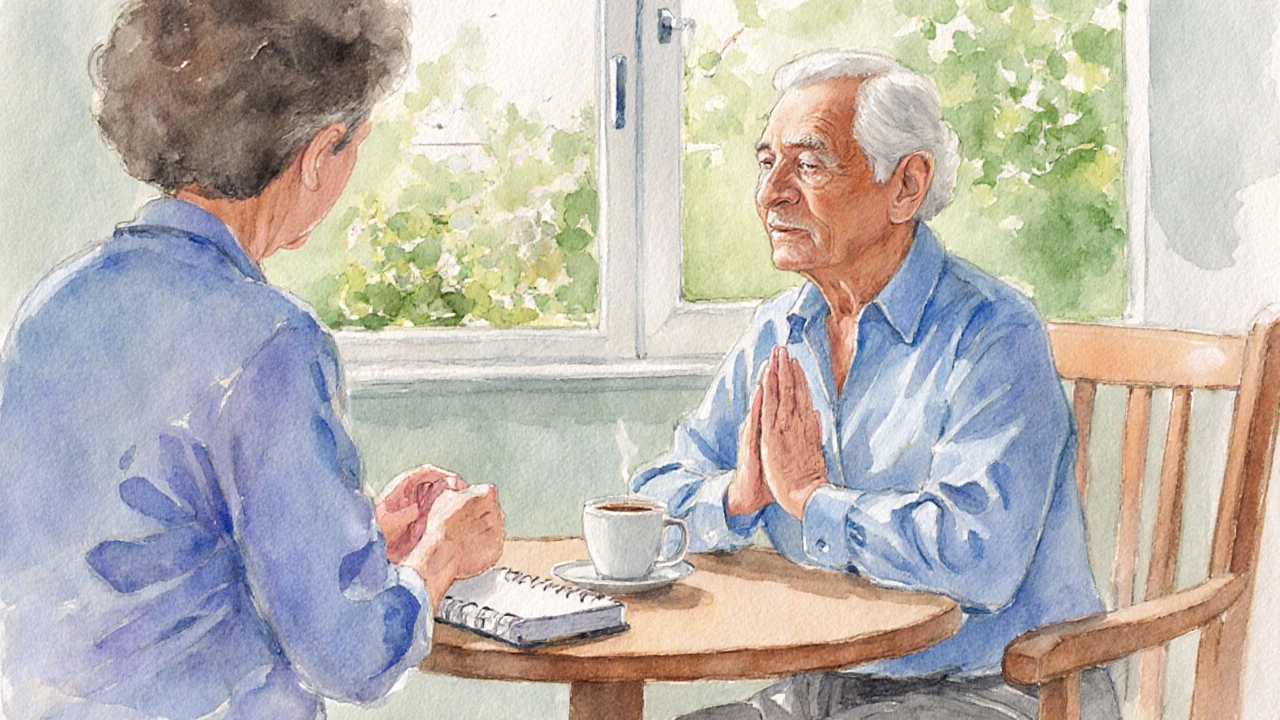Maintaining Comfort & Well-Being as You Age

Comfort & Well-Being Tracker
Mark off the comfort habits you've completed today:
Your comfort score based on today's habits:
Each completed habit adds 16.67% to your comfort score.
Aim for 100% to maximize your daily well-being!
Select some comfort habits to see your personalized tip!
Living longer doesn’t have to mean living with aches, low energy, or constant worry. The goal is simple: stay comfortable and feel good every day, no matter how many birthdays you’ve celebrated. Below you’ll find practical habits, home tweaks, and mental‑health tricks that let you keep moving, sleeping, and enjoying life without the nagging discomfort that many associate with getting older.
Key Takeaways
- Identify the three most common sources of age‑related discomfort and target them with specific actions.
- Adopt a daily comfort routine that blends gentle movement, proper nutrition, and good sleep hygiene.
- Make low‑cost home modifications that improve posture, reduce strain, and boost safety.
- Use proven mental‑health techniques to keep stress and mood swings in check.
- Know the warning signs that require a professional’s eye, so you stay ahead of serious problems.
Understanding the Roots of Discomfort
First, let’s name the culprits. Discomfort is the feeling of physical unease caused by joint stiffness, muscle loss, or chronic conditions that become more common with age. It typically stems from three areas:
- Joint & Muscle Changes - cartilage thins, muscles shrink, and flexibility drops.
- Sleep Disruptions - night‑time bathroom trips, breathing issues, or restless legs interrupt deep sleep.
- Mental Strain - worries about health, finances, or loss can tighten muscles and amplify pain.
Knowing where the pain originates lets you choose the right fix instead of a one‑size‑all approach.
Daily Habits that Boost Physical Comfort
Physical activity is any movement that raises heart rate, strengthens muscles, and maintains joint range of motion. A consistent routine reduces stiffness and supports bone density.
- Morning Stretch Series (5‑10 minutes): cat‑cow, shoulder rolls, ankle circles, and seated forward bends. Focus on moving each joint through its comfortable range.
- Low‑Impact Cardio (20‑30 minutes, 3‑4 times a week): brisk walking, water aerobics, or stationary cycling. Aim for a moderate exertion level where you can talk but not sing.
- Strength Circuit (twice weekly): body‑weight squats, wall push‑ups, resistance‑band rows, and seated leg lifts. 2‑3 sets of 8‑12 reps each.
Start with what feels doable and add minutes as you get stronger. The key is consistency, not intensity.

Nutrition and Hydration for Comfortable Aging
Nutrition is the intake of foods and fluids that provide essential vitamins, minerals, and energy for bodily functions. A well‑balanced plate can lower inflammation and support joint health.
- Omega‑3 Rich Foods: salmon, chia seeds, walnuts - aim for 2‑3 servings weekly.
- Calcium & Vitamin D: low‑fat dairy, fortified plant milks, leafy greens. Combine with safe sun exposure or a supplement if blood levels are low.
- Anti‑Inflammatory Spices: turmeric, ginger, cinnamon - add a pinch to soups or smoothies.
- Hydration: 1.5‑2L of water daily, more on hot days or when exercising.
Track your meals for a week; you’ll spot gaps you can fill without overhauling your diet.
Sleep Hygiene: The Night‑time Comfort Pillar
Sleep is the restorative period when the body repairs tissues, balances hormones, and consolidates memory. Poor sleep magnifies pain perception.
- Consistent Schedule: go to bed and rise at the same time, even on weekends.
- Bedroom Environment: keep the room cool (65‑68°F), dark, and quiet. Use blackout curtains or a white‑noise machine.
- Pre‑Sleep Routine: limit screens 30minutes before bed, try gentle breathing or a short gratitude journal.
- Limit Liquids after dinner to reduce nighttime bathroom trips.
If you still wake up feeling sore, a short 5‑minute gentle stretch before getting out of bed can ease stiff muscles.
Home Modifications that Reduce Strain
Home modifications is simple changes to living spaces that improve safety, posture, and accessibility for older adults. Most cost less than $500.
| Improvement | Typical Cost | Primary Benefit | Best For |
|---|---|---|---|
| Non‑slip bathroom mats | $30‑$70 | Prevents falls on wet floors | Anyone with limited balance |
| Lever‑style faucet handles | $50‑$120 | Reduces grip strain | People with arthritis |
| Adjustable bed base | $300‑$500 | Improves sleeping posture | Those with back pain |
| Roll‑under bathroom grab bar | $40‑$80 | Provides support when standing | Individuals needing extra balance |
| Walker or rollator | $150‑$300 | Offers stability during ambulation | Anyone with moderate gait issues |
Start with the low‑cost items that address your most frequent pain points, then upgrade as needed.

Mental‑Health Practices for Whole‑Body Comfort
Mental health is the emotional and psychological state that influences how we think, feel, and act. Stress fuels muscle tension and can turn minor aches into chronic pain.
- Mindful Breathing (5 minutes daily): inhale for 4 counts, hold 2, exhale 6. This activates the parasympathetic nervous system.
- Social Connection: schedule weekly coffee dates or virtual chats. Feeling supported reduces cortisol levels.
- Purpose‑Driven Activities: volunteering, gardening, or learning a hobby gives your brain a positive focus.
- Professional Support: if anxiety or depression lasts more than two weeks, seek a therapist or counselor.
Even small mental‑wellness habits can lower the perception of physical discomfort.
When to Call in Professional Help
Self‑care works for everyday aches, but certain signs mean it’s time to see a specialist:
- Sudden, severe pain that doesn’t improve after a few days.
- Persistent joint swelling, redness, or warmth.
- Unexplained weight loss, fever, or night sweats.
- Difficulty sleeping despite all sleep‑hygiene steps.
- Feeling isolated, hopeless, or having thoughts of self‑harm.
Primary care physicians can screen for underlying conditions; physical therapists can tailor safe exercise plans; and occupational therapists can suggest customized home modifications.
Frequently Asked Questions
How much exercise is safe for someone over 70?
The American College of Sports Medicine recommends at least 150 minutes of moderate‑intensity aerobic activity per week, broken into 30‑minute sessions most days. Add two days of strength training focusing on major muscle groups. Start slow, listen to your body, and increase duration by no more than 10% each week.
Can dietary changes really ease joint pain?
Yes. Foods high in omega‑3 fatty acids, antioxidants (berries, leafy greens), and anti‑inflammatory spices have been shown in clinical studies to reduce markers of inflammation, which often correlate with less joint discomfort.
What’s the most cost‑effective home change for better sleep?
A blackout curtain or a simple eye mask can cut out light pollution instantly. Pair it with a small fan or white‑noise app to keep the room cool and quiet.
Are walkers safe for indoor use?
Modern walkers have smooth‑rolling wheels and rubber tips that glide over carpet without scratching. Choose a model with a built‑in seat for quick rests, and keep pathways clear of clutter.
What mental‑health sign should never be ignored?
Any persistent feeling of hopelessness, loss of interest in previously enjoyed activities, or thoughts of self‑harm warrants immediate professional attention. Early intervention can prevent escalation.

Howard Mcintosh
October 8, 2025 AT 20:25Yo, this guide is a solid starter pack for staying comfy as we get older! Just jump into those morning stretches and you’ll feel the difference in a few days. Keep the water bottle handy-hydration is key, and don’t worry if you miss a day, just get back on track. Tiny wins add up, so stay consistent and watch that comfort score climb. Let’s keep each other motivated and crush those habits together!
Jeremy Laporte
October 8, 2025 AT 22:00First off, kudos for putting together such a comprehensive routine-it's exactly what many of us need to feel better day‑to‑day. The blend of gentle movement, proper nutrition, and sleep hygiene hits all the right notes for overall well‑being. Starting with just five minutes of stretch can make joints feel less stiff, and the low‑impact cardio options are perfect for keeping the heart healthy without over‑exertion. Hydration, as you mentioned, is often overlooked but plays a huge role in joint lubrication and energy levels. The sleep tips-consistent schedule, dark room, cool temperature-can dramatically improve how refreshed you feel each morning. Home modifications like non‑slip mats and lever‑style faucets are simple fixes that can prevent injuries and reduce strain, especially for those with arthritis. The mental‑health strategies, especially mindful breathing and staying socially connected, are crucial because stress can amplify physical pain. Remember, progress doesn’t have to be perfect; consistency beats intensity every time. If you keep tracking your habits, you’ll see patterns and be able to adjust as needed. Also, consider adding a short gratitude journal before bed to boost mood and sleep quality. Keep up the great work, and feel free to share any personal tweaks that have helped you stay comfortable-you might inspire someone else!
Seth Angel Chi
October 8, 2025 AT 23:40While the advice sounds generic it overlooks individual variability simplicity alone does not guarantee efficacy
Kristen Ariies
October 9, 2025 AT 01:20Absolutely love the thoroughness of this guide; it captures the essential pillars of aging gracefully-movement, nutrition, sleep, environment, and mindset-and weaves them together in a way that feels both practical and inspiring!; The morning stretch series, though brief, sets a purposeful tone for the day, loosening tight muscles and priming the nervous system; Low‑impact cardio options like walking or water aerobics provide cardiovascular benefits without excessive joint stress, a perfect balance for many adults; Strength circuits, even with body‑weight movements, maintain muscle mass and support bone density, which are critical as we age; Nutrition advice emphasizing omega‑3s, calcium, vitamin D, and anti‑inflammatory spices offers a solid foundation for joint health and overall vitality; Hydration recommendations are spot‑on-adequate water intake lubricates joints and aids metabolic processes; The sleep hygiene section, with its emphasis on consistency, environment, and pre‑sleep routines, directly tackles one of the most common disruptors of comfort; Home modifications, from non‑slip mats to adjustable bed bases, illustrate how small investments can dramatically reduce daily strain; Lastly, the mental‑health practices-mindful breathing, social connection, purpose‑driven activities-recognize the profound mind‑body connection; Overall, this multi‑faceted approach not only addresses physical discomfort but also nurtures emotional resilience, making it a truly holistic roadmap for comfortable aging.
Earl Hutchins
October 9, 2025 AT 03:00Pro tip: pair the morning stretch with a quick protein shake-adds muscle‑repair fuel right after you mobilize those joints. Also, consider swapping plain water for infused cucumber‑mint water; it keeps you hydrated and adds a subtle antioxidant boost.
Dhananjay Sampath
October 9, 2025 AT 04:40Great rundown!; A couple of gentle reminders: always test new home modifications for stability before relying on them, and if you ever feel persistent joint pain, a quick check‑in with a physical therapist can save you from bigger issues down the line; Keep fostering that supportive community vibe!
kunal ember
October 9, 2025 AT 06:20Reading through this comprehensive guide, I could not help but notice the elegant interweaving of physiological, psychological, and environmental factors that collectively contribute to the nuanced experience of comfort during the later stages of life; The systematic breakdown of joint and muscle changes, juxtaposed with actionable low‑impact exercise recommendations, establishes a pragmatic framework that honors both the limitations and potentials inherent in an aging musculoskeletal system; Moreover, the emphasis placed upon sleep hygiene transcends simple bedtime routines, illuminating the profound influence of circadian consistency upon regenerative processes and inflammatory modulation; By introducing nutrition strategies rich in omega‑3 fatty acids and anti‑inflammatory spices, the author not only acknowledges the biochemical underpinnings of joint health but also provides accessible dietary pathways that can be seamlessly integrated into everyday meals; The inclusion of home modifications, ranging from non‑slip mats to adjustable bed bases, exemplifies a keen awareness of the built environment’s role in either mitigating or exacerbating physical strain, thus encouraging a proactive stance toward safety and ergonomics; Additionally, the mental‑health component-encompassing mindful breathing, social connectivity, and purpose‑driven activities-recognizes the bidirectional relationship between psychological stressors and somatic symptomatology, reinforcing the necessity of holistic self‑care; In synthesis, this guide offers a multidimensional scaffold upon which individuals can construct personalized comfort regimens, thereby fostering not only physical ease but also emotional resilience, ultimately contributing to an enriched quality of life as we advance in years.
Kelly Aparecida Bhering da Silva
October 9, 2025 AT 08:00Sure thing, the government’s agenda is pushing us away from natural wellness.
Michelle Dela Merced
October 9, 2025 AT 09:40🔥🔥 This whole comfort checklist feels like a covert operation to keep us sedated! We need to take back our bodies and reject these soft‑pill wellness programs! 💥💥
Bobby Hartono
October 9, 2025 AT 11:20i really think the part about adding turmeric and ginger is spot on, it's a simple habit that can make a huge difference in reducing inflammation; also, i love how the guide reminds us to keep our rooms cool and dark, that can totally improve sleep quality; and dont forget to stay socially connected, because loneliness actually ramps up pain perception, which is something many overlook; overall i recommend people take these steps one at a time, maybe start with the water intake, then move to the stretches, and you will notice the compounding benefits over weeks; small consistent actions are the real game changers for maintaining comfort as we age.
Josephine Bonaparte
October 9, 2025 AT 13:00Look, the core ideas are solid but the execution matters-keep the language clear, avoid extra fluff, and make sure each habit is truly doable. If you’re pushing a habit that feels like a chore, people will quit. Streamline the steps, focus on one habit at a time, and track progress honestly. No need for hype, just consistent effort.
Meghan Cardwell
October 9, 2025 AT 14:40From a health‑tech perspective, integrating a simple mobile tracker for these habits could boost adherence dramatically; think push notifications for water intake, seamless logging of stretch durations, and AI‑driven tips based on user compliance patterns-this data‑centric approach can personalize the comfort journey and accelerate outcomes.
stephen henson
October 9, 2025 AT 16:20👍 Great guide! 🚀 Adding a quick 2‑minute breathing exercise before bed can really calm the nervous system and improve sleep quality. 😊
Mike Rylance
October 9, 2025 AT 18:00In summary, this multifaceted approach-combining structured physical activity, targeted nutrition, optimized sleep environment, modest home adaptations, and mental‑wellness practices-constitutes a robust framework for preserving comfort and functional independence in later adulthood. By adhering to these evidence‑based recommendations, individuals can mitigate age‑related discomfort, enhance quality of life, and maintain autonomy.